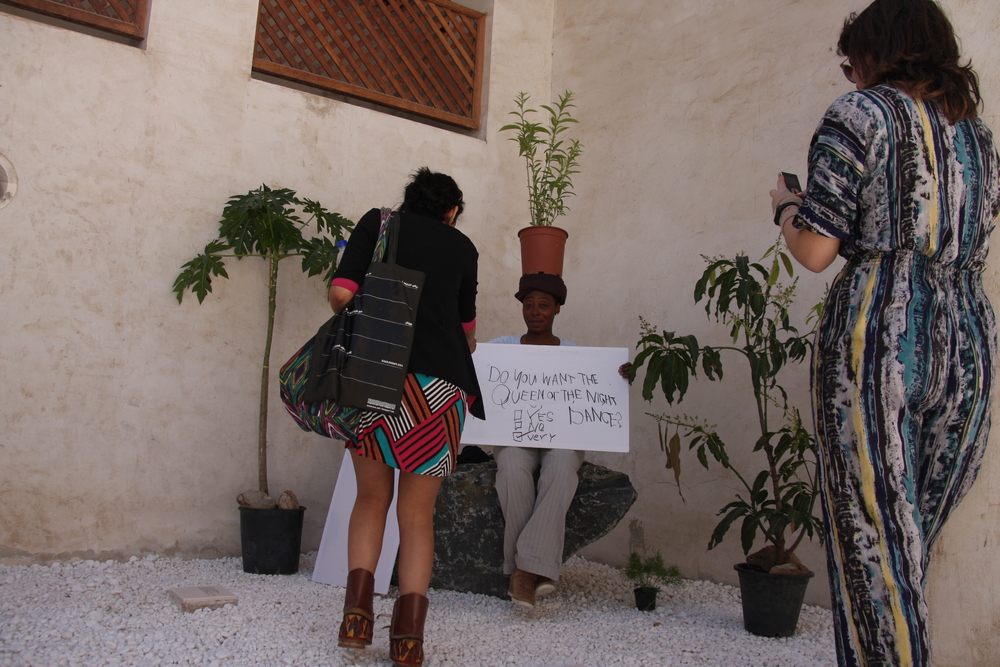Shows
Sharjah Biennial 11 Report: The Opening


It is easy to get lost in the labyrinthine passages, baking courtyards and rooftop terraces of the Sharjah Biennial 11, this year featuring over 100 artists and 42 newly commissioned works, many of which chart the cartography and choreography of space. But a visitor can delight in this sensation, approximating the feeling of surprise and danger, and be almost disappointed when oriented by a sign or obliging guide.
Curated by Yuko Hasegawa, “Re:emerge Towards a New Cultural Cartography” takes on the theme of public space and utilizes the historic sites of the small Emirate. Although the show may sentimentalize Islamic medinas—where, Hasegawa genuflects, “water, greenery and sunlight [created] an analogy with paradise . . . a plane of experience and experimentation—an arena for learning and critical thinking”—the artworks are guided by a pragmatic spirit. If an argument is being made, it is that the priorities of the artist and the architect are the same. The works thrive at the happy intersection of art and social life, all the while safely bypassing confrontational or explicit critiques.
Indeed, although Hasegawa looks to the past—evoking Arabian nights spent sleeping on cool rooftops and footnoting 13th-century accounts of peripatetic scholars—the theme inevitably brings to mind more recent history. After all, public space, particularly censorship within its confines, became the accidental subject of the Biennial’s last edition when two works were removed. An installation by the Algerian artist Mustapha Benfodil that included texts with graphic accounts of rape resulted in the dismissal of the director of the Sharjah Art Foundation Jack Persekian. In addition, the film Plot for a Biennial (2011), commissioned from American artist Cavah Zahedi, was dropped before the event’s opening, purportedly for disrespecting Islam.
The theme of this year’s biennial, though suggestive of such issues, is not aggressively corrective or retrospective, and the artworks, on the whole, are luxuriously mild. Here is a quick walk-through of the first day . . .
On the opening morning, a Sufi composition produced by the Biennial’s team in collaboration with Egyptian artist Wael Shawky, Dictums 10:120 (2013), drew together visitors and provided a spirited soundtrack for those flowing through the exhibition spaces. The lyrics were an Urdu translation of the curatorial statements for the 2011 edition of the Biennial, adapting contemporary art jargon to the structures of traditional qawwali devotional music.

At the opening, Nigerian artist Otobong Nkanga balanced a potted plant on her head and danced as “the queen of the night” in a courtyard of white pebbles intermingled with photographs emblazed on limestone. In a surreal moment, while performing with the plant the artist shook the hand of the Sheikh, who appeared somewhat embarrassed by the interaction.

Around the mosque, Brazilian artist Ernesto Neto built a yurt-like structure covered with rope netting. Pendulous udders hung heavy with rocks and ice blocks that dripped into the green oasis beneath. The work, Enquanto a Cultura Nos Separa, a Natureza Nos Une (While Culture Moves Us Apart, Nature Brings Us Together) (2013), brings to mind the opening pages of Gabriel García Márquez’s One Hundred Years of Solitude, which describe the discovery of ice and old stones the shape of dinosaur eggs.

Japanese artist Shiro Takatani also created an oasis. Composition (2013), a fog machine logged the courtyard with water and muted the intense morning sunlight. The natural world was a force of redemption often in the show. Turkish artist Nevin Aladağ’s Session (2013) was a three-channel video installation and composition made in Sharjah. Drums hit by sea waves, golden bells sledding over dunes and tambourines rolling through the streets created a melody composed by nature.


Francis Alÿs’ new work explored geography and its cruel ironies. In a film, young boys confront the thrashing sea with sailboat flip-flops in hand. Like some sort of children’s crusade, they attempt to cross the Strait of Gibraltar, the 14 kilometers separating Africa from Europe. Outside, on a flat image of a map, Alÿs balances two forks across the channel to represent the continent’s absurd proximity. Meanwhile, Marwan Rechmaoui maps the Palestinian camps in Lebanon in a faux-naif style.

The commissioned artworks are often architectural interventions. Carlos Amorales’s We’ll See How All Reverberates (2012) is an Alexander Calder-inspired mobile made out of cymbals. A row of mallets hangs invitingly on a nearby wall.

Wooden structures built by Chinese artist Liu Wei out of old doors and panels rise grandly like sealed cathedrals, while Lúcia Koch’s light-filtering panels hang over the courtyard of Bait Habib Shalawani with the effect of stained-glass windows.


The United Arab Emirates has a tiny population of citizens and many permanent residents, but is host to a huge temporary workforce of non-citizens from Africa, South Asia and elsewhere in the Middle East. The question “who is the public?” is a confused issue for the nation, let alone for the Biennial. The collective SUPERFLEX interviewed migrant residents about the objects they remember from public spaces from home and replicated the slides, swings and umbrellas on Bank Street's black dune strip.

In another case, the artwork is architecture. The German architect Ole Scheeren collaborated with Thai filmmaker Apichatpong Weerasethakul on Mirage City Cinema, the space where the Biennial’s film program will show later this week. The open-air space will be covered with oriental carpets and floor cushions for seating. In some sense the sunken rooftops that the platforms evoke are a radical intervention in that they confound the logic of the tall, slender corporate buildings mushrooming across the United Arab Emirates.

Noelle Bodick is assistant editor of ArtAsiaPacific and is based in Hong Kong.







